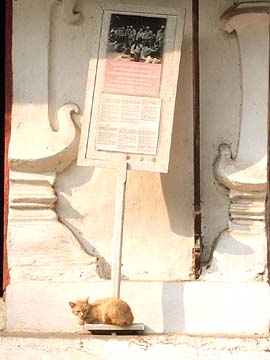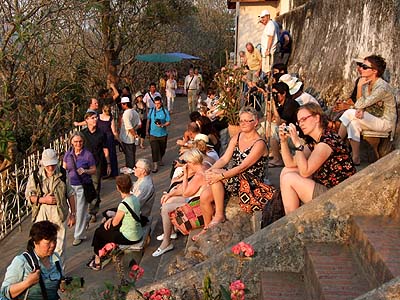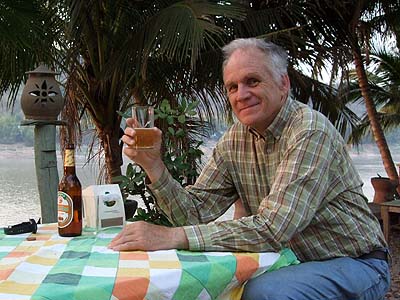Patrimoine Mondial, Luang Prabang 2009
We visited Laos (and Thailand) on our way back to base after a month in Burma which is described in detail in Rob and Yuehong in the Golden Land 2009.
And as for the rest of the return trip to China from Burma, it's all much as in the back-packer guide books. Even if Laos might be off the beaten track to many readers, in fact these days it's a well trodden trail and not particularly cheap because the local currency (Kip) has appreciated significantly against a strengthening dollar in the last year. The 'Jewel in the Crown' of Lao tourism has to be the old town of Luang Prabang, the ancient royal capital of the country and now, deservedly, a World Heritage Site. Let me say from the outset, lest I be accused of doing a hatchet job, that as such places go I would give it 8/10. The problem, as ever, is to balance preserving something valuable while at the same time servicing the mass of tourists and providing much needed income for what has been until now a very poor local community.
Apart from the temples, schools and a few old administrative buildings, it seems that almost everything in the old part of town is a hotel, guest house, restaurant, travel agency, internet cafe or souvenir shop, each accommodated in an extremely tastefully restored or beautifully (re)constructed edifice. And those few that do not yet fall into this category soon will.
The vast majority of the thousands of tourists from back packers to baby boomers who throng the streets seem to know how to behave in a civilised manner. However, I could definitely have done without those (mainly but not exclusively Asians) who think 100 metres is too far to walk and tour the town in air-conditioned SUVs. "Excuse me, you're blocking the footpath!", I remarked tartly to one perspiring group waiting to be picked up for the incredibly short journey to the next 'must do' sight.
Overall, the effect is a bit like eating Black Forest Gateau non-stop for days on end, but compared to the Chinese version (Lijiang) across the border it's paradise. I dread to think what will happen to the place when they start jetting in from Kunming in their thousands; should anyone ask me what I think of Chinese civilisation, I quote Mahatma Ghandi who when asked the same question of western civilisation replied that "It would undoubtedly be a good idea".
|
The many temples ('Vat') around the town are totally 'real' and extremely beautiful, sensibly the more famous ones now charge for admission: |
|
|
|
|
|
For the time being many of the 'normal' buildings are safe, but what might politely be called 'change of use' leaves others greatly devalued. |
|
|
|
|
|
The Mekong is as attractive as ever, but the boats are for tourists, while the smaller Nam Khan has a bamboo bridge ideal for getting to yet another riverside restaurant. |
|
|
|
|
|
All pockets are catered for, you can have breakfast on the terrace of your villa hotel or immediately opposite in a small Lao cafe. |
|
|
|
|
|
Especially along the Nam Khan waterfront there are still some houses used as family homes: |
|
|
|
|
|
|
|
|
Just how long they will be able to survive the onslaught of this ghastly modern so-called heritage hotel which is creeping like a strangler vine along the same street is another matter. In the early morning, staff were thoughtlessly warming up the engines and adding to the town's growing air pollution problem which on a still day now reaches Beijing proportions, made worse by 'slash and burn' cultivation in the surrounding hills: |
|
|
|
|
|
Monks are big business, so much so that the temples have had to post notices to tell the tourists how to behave. Never mind, there is plenty of more conventional food around: |
||
|
|
|
|
|
It's bad enough watching overweight foreign tourists (Western and Asian) going round the sites in air conditioned SUVs, but monks too? |
|
|
|
|
|
Accommodation is not difficult to find, there are streets which are now full of almost nothing but guest houses and there are more going up all the time. Ready, steady, build: |
|
|
|
|
|
|
|
|
Finally signs that in some respects, things are going very badly wrong, any comment would be totally superfluous: |
|
|
|
|
|
As for the local inhabitants, they take a very relaxed view on life: |
|
|
|
|
|
When I was in Luang Prabang 10 years ago in a former existence, there were maybe half a dozen tourists at the hill top temple for the sunset. This time, with half an hour or more to go, you needed to have put your towel or bottom down well in advance and the numbers were growing by the second: |
|
|
|
|
|
We passed a couple of hundred more ascending while on the steps going down and retreated to the river bank where a Beer Lao is more than socially acceptable: |
|
|
|
|
|
It is an unfortunate fact of life that I have to eat three times as much as Yuehong to avoid fading away completely, most of the time here that means rice noodles. For Yuehong, it's time for a fruit diet... |
|
|
|
|
|
And what's the best thing in Laos after the Beer Lao? I'd have to say the all day baguette, a perfect antidote to 6 weeks of non-stop rice in any shape or form: |
|
|
|
|
Anyway, Luang Prabang was a great place to chill out for three days from the rigours of Burma and get the commentaries written for our new DVDs. And I have to admit I'm looking forward to breaking one of our next journeys to and from Burma here later in the year.
Travel details, we call ourselves 'comfortable budget travellers', we use public transport where possible and pay a little bit more than the minimum for accommodation but always eat locally. These days with globalisation, it is impossible to 'travel on a shoestring' any more.
Money
-
During our visit USD 1 = LKP 8500, there are ATMs in Vientiane and Luang Prabang, the country accepts LKP, USD, THB and (in the north) CNY.
Vientiane from Thailand
-
To Nong Khai by bus (day time from Khon Kaen / Udon Thani) or train (overnight from Bangkok/Ayutthaya), tuk-tuk to border - there is a direct Khon Kaen to Vientiane bus if you have a Lao visa already (THB 180).
-
Very efficient visa-on-arrival - one photo needed - at the north end of the Friendship Bridge - USD 20 (China) to USD 42 (Canada) according to nationality, EU countries USD 35. There is a USD 1 surcharge outside normal Monday - to - Friday office hours. Don't pay in THB, buy USD at the exchange booth if you are short.
-
Lao Kip ATM next to immigration (very slow)
-
Regular bus (LKP 10,000) to town just outside on leaving immigration, charter tuk-tuks etc available here too
-
Lots of guest houses in the centre of town USD 20-25 with AC and attached bathrooms
Vientiane to Luang Prabang, 9-10 hours, bookable at north bus station, available from hotels and tour agencies at a significant premium, road is good but curvy and undulating
-
VIP bus 08.00, 09.00, LKP 115,000
-
AC bus 06.30, 07.30, 09.00, LKP 95,000
Vientiane to China direct
-
Mengla (south of Jinghong), 11.00, CNY 200
-
Vientiane, 14.00, CNY 436
Luang Prabang
-
Dozens of guest houses USD 10-15, they'll find you at the bus station. LP 10,000 per person on a tuk-tuk, minimum 2 persons.
Luang Prabang to Jinghong (China)
-
Daily bus from north bus station to Luang Nam Tha, 09.00, LKP 65,000, road is variable but curvy and undulating, being upgraded in parts.
-
Alight at Na Teuy (7½ hours), junction for border - even though it's a small village you can't miss it.
-
2 new more than adequate guest houses on left side after bridge on the Luang Nam Tha road just after the junction.
-
Dali Chinese restaurant on right side just before junction - the rooms in their guest house are too basic even for us, when there is better available!
-
Next morning we took an 08:00 charter pick-up (CNY 50) to (ghastly) Boaten for Lao immigration and on to Mohan for Chinese immigration. Said to be open 08:00 to 16:00, both very efficient, courteous and swift.
-
Regular minibus to Mengla (CNY 17, one hour), #1 bus (CNY 1) to main (north) bus station, frequent midi-buses to Jinghong (CNY 38, just 2 hours on the new road), arriving at the 'middle' bus station.
-
Alternative is 09.00 bus to Oudomxay, (4½ hours) - part way to Luang Nam Tha - overnight in a guest house there and take the direct bus (08:00, CNY 80) next morning to Jinghong (18.00). It is said to pass Nateuy about 11.30. There should be a second bus from Oudomxay based on information gleaned in Jinghong.
More
-
We have a copy of the slim Lonely Planet 'Greater Mekong' Book 2007 - there are now significantly more (day) buses on each of the sections between Luang Prabang and Kunming than it suggests.
-
One Oudomxay bus leaves from the main (most northerly) bus station in Jinghong (time not known but likely to be early) - there are at least two more bus stations here!
-
Another Oudomxay bus leaves from the most southerly bus one at 11.40 (CNY 90).
-
The many Kunming day buses (CNY 182, 9-10 hours, depending on the traffic jams in Kunming) leave from the most southerly one and the Mengla buses from one roughly in between (but on a side street)!
-
We fancy going from Jinghong via Huay Xai to Thailand next time. The south bus station in Jinghong advertises a bus to Luang Nam Tha at 10.40. One visitor told us that the road on to Huay Xai is not too bad and is being upgraded.
-
With care there should be no need to stay in Mengla, Mohan or Boaten, none of which I can think of a good word to describe. Boaten in particular has a giant hotel complex being constructed which I guess is for Chinese gamblers.
-
Jinghong is a great transit point, but the rose-coloured glasses worn by the guide book writers should not disguise the fact that this is now yet another Chinese city.
-
Treat all the above with caution, it was current at the end of February 2009.


































